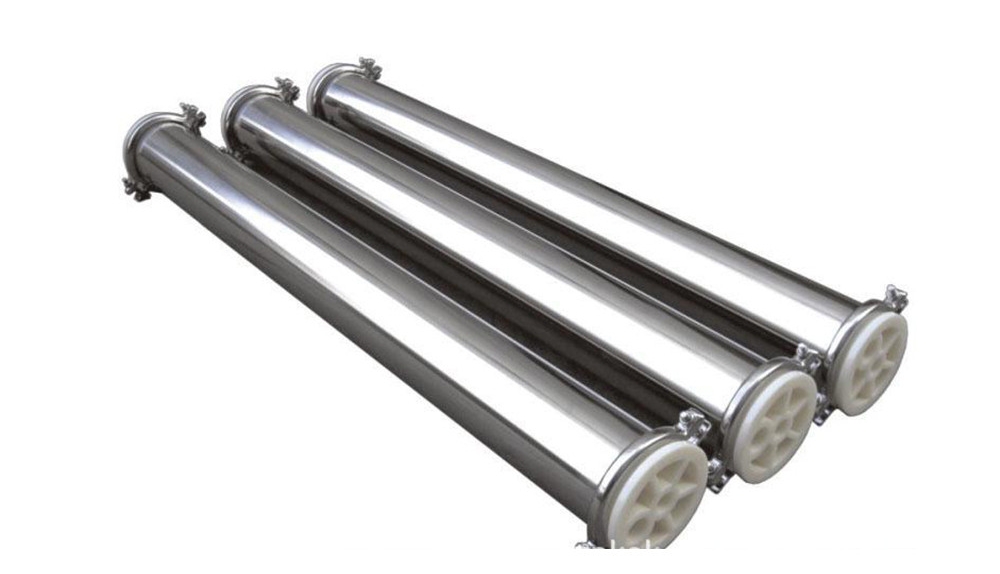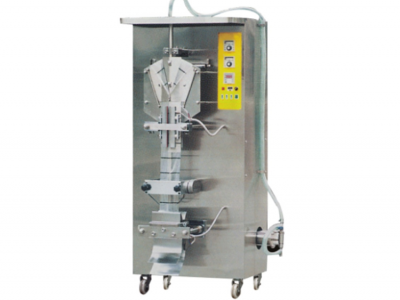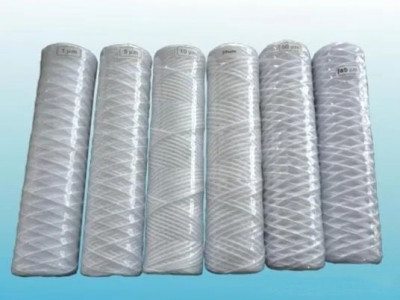تصنيف وخصائص العلب الغشائية
المساكن الغشاء، وهي مكونات أساسية في أنظمة تنقية المياه بالتناضح العكسي، وعادةً ما يتم تصنيعها من مادة PP الغذائية أو الألياف الزجاجية أو الفولاذ المقاوم للصدأ باستخدام عمليات درجة الحرارة العالية أو الذوبان. وظيفتها الأساسية هي استيعاب مختلف أغشية الترشيح الفائق والتناضح العكسي ذات الأحجام المقابلة، مما يضمن أداء الترشيح الأمثل ومنع تسرب المياه أو تدهور الجودة. يقدم السوق أربعة أنواع رئيسية من العلب الغشائية بناءً على تركيب المواد:
1. العلب غشاء البلاستيك PP
تحظى أغلفة الأغشية البلاستيكية PP حاليًا بشعبية كبيرة، وتتميز بما يلي:
مزايا:
– مرونة جيدة وخفيفة الوزن
– التكيف الذاتي مع اختلافات ضغط المياه
– تكلفة منخفضة نسبيا
العيوب:
– مقاومة التآكل ضعيفة
– مقاومة الضغط محدودة
– مقاومة الشيخوخة دون المستوى الأمثل
– احتمالية تلف الجدار الخارجي والتسرب تحت الضغط العالي
2. العلب غشاء أنبوب زجاجي شفاف
تجد هذه المساكن تطبيقًا في صناعات محددة وتتميز بما يلي:
مزايا:
– مقاومة الضغط أعلى من العلب البلاستيكية
– الفحص البصري المباشر لحالة الغشاء
– النداء الجمالي
العيوب:
– الهشاشة وانخفاض مستوى السلامة
– استخدام محدود، في المقام الأول في الصناعات المتخصصة
– يتطلب رعاية إضافية أثناء التثبيت والصيانة
تستخدم العلب المصنوعة من الفولاذ المقاوم للصدأ في الغالب في منتجات تنقية المياه التجارية والصناعية، وتوفر ما يلي:
مزايا:
– جودة متفوقة ومقاومة الضغط العالي
– مقاومة ممتازة للشيخوخة
– مقاومة جيدة للتآكل
– عمر خدمة ممتد
العيوب:
– متطلبات صارمة لجودة المواد
– تكلفة أعلى
– وزن كبير، غير مناسب للنقل المتكرر
تتكون علب الألياف الزجاجية، التي يتم إنتاجها من خلال اللف الأوتوماتيكي الذي يتم التحكم فيه بواسطة الكمبيوتر، بشكل أساسي من راتنجات الإيبوكسي والألياف. أنها تتميز:
مزايا:
– مقاومة ممتازة للضغط ودرجة الحرارة والتآكل
– خصائص عزل متفوقة
– بناء خفيف الوزن
– مقاومة قوية للتآكل
– إمكانية التخصيص العالية
العيوب:
– عملية تصنيع معقدة، وتكاليف أعلى محتملة
– قد يتطلب مهارات متخصصة للإصلاح والصيانة
تحليل مفصل لعلب غشاء الفولاذ المقاوم للصدأ
تعتبر الأغطية الغشائية المصنوعة من الفولاذ المقاوم للصدأ، والتي يتم تصنيعها عادةً من أنابيب غير ملحومة من الفولاذ المقاوم للصدأ 304، مكونات أساسية في المعدات الميكانيكية. تشمل الميزات الرئيسية ما يلي:
1. التصنيف:
– بواسطة ختم الغطاء النهائي: نوع المشبك، نوع الشفة، النوع المدمج
– بواسطة طريقة مدخل المياه: مدخل نهاية، مدخل جانبي
2. خصائص الأداء:
– الطول متوافق مع كمية مكون غشاء التناضح العكسي
– تلميع داخلي وخارجي من أجل الجماليات والأداء الوظيفي
– الضغط التشغيلي يلبي متطلبات النظام
– مقاومة قوية للتآكل، ومناسبة لبيئات نوعية المياه المختلفة
– هيكل مستقر مقاوم للتشوه
3. التطبيقات:
تُستخدم الأغطية الغشائية المصنوعة من الفولاذ المقاوم للصدأ على نطاق واسع في السيناريوهات التي تتطلب أداءً عاليًا ومتانة، بما في ذلك:
– أنظمة تنقية المياه التجارية (المطاعم، المقاهي، الفنادق)
– معالجة المياه الصناعية (الصناعات الكيميائية والصيدلانية والصناعات الغذائية)
– معدات تحلية مياه البحر
– أنظمة معالجة المياه ذات الضغط العالي
4. المعدات المتوافقة:
– أجهزة تنقية المياه بالتناضح العكسي للاستخدام المنزلي والتجاري
– أنظمة التناضح العكسي الصناعية لعمليات الضغط العالي واسعة النطاق
– معدات الترشيح الفائق لإزالة الجسيمات الدقيقة والشوائب
تحليل مفصل لمساكن غشاء الألياف الزجاجية
يتم تصنيع أغطية أغشية الألياف الزجاجية باستخدام آلات لف يتم التحكم فيها بواسطة الكمبيوتر ومعدات معالجة عالية الأداء. تشمل ميزات الأداء الرئيسية ما يلي:
1. جودة داخلية ممتازة:
– عملية لف أوتوماتيكية يتم التحكم فيها بواسطة الكمبيوتر
– المواد الأولية: راتنجات الايبوكسي والألياف
– معالجة خاصة للضغط الفائق ودرجة الحرارة ومقاومة التآكل
2. خصائص العزل متفوقة:
– تتراوح الموصلية الحرارية عادةً بين 0.15-1.36 واط/(م·ك) في درجة حرارة الغرفة
– عزل حراري أفضل بكثير من المواد المعدنية
– العزل الفعال لتأثيرات درجة الحرارة الخارجية على الغشاء
3. مقاومة التآكل المتميزة:
– نسبة خاصة ومعالجة معالجة للألياف الزجاجية وراتنجات الايبوكسي
– ثبات جيد ضد الأحماض والقلويات والأملاح والزيوت منخفضة التركيز
– مقاومة فعالة لمياه البحر والتأثيرات الميكروبية
– استخدام طويل الأمد دون مشاكل التآكل
4. التصميم الهيكلي الأمثل:
– تصميم صارم لرمية الكرة وتحسين مناطق البرميل والرأس والفتحة
– يضمن السلامة الهيكلية والاستقرار تحت الضغط على المدى الطويل
– فتحات جانبية مركزة محسنة لمتطلبات الضغط الآمن
5. تصميم مكونات موثوقة:
– ألواح نهائية مصنوعة من البلاستيك المقوى بالألياف للحصول على قوة عالية ومقاومة للضغط
– المتخصصة “الخامس + العاشر” تصميم الختم الدائري مع ختم لوحة نهاية الحلقة O
– يحافظ على أداء إغلاق ممتاز عبر نطاقات درجات الحرارة المنخفضة والعالية
6. أداء المنتج العام عالي الجودة:
– هيكل داخلي آمن وموثوق
– تكامل ممتاز للمكونات لتحسين أداء الختم والضغط
– معالجة سطحية خارجية فائقة من أجل المتانة في البيئات الرطبة
7. التطبيقات:
تعتبر الأغطية الغشائية المصنوعة من الألياف الزجاجية مناسبة لمختلف البيئات والمعدات نظرًا لمقاومتها الممتازة للتآكل وخصائص العزل، بما في ذلك:
– مرافق معالجة المياه البلدية (مياه الشرب ومياه الصرف الصحي)
– محطات تحلية مياه البحر
– أنظمة الري الزراعية
– معدات حماية البيئة (أنظمة تنقية الهواء ومعالجة مياه الصرف الصحي)
8. المعدات المتوافقة:
– معدات تنقية المياه بالترشيح الفائق
– أنظمة الترشيح النانوية
– أجهزة معالجة المياه البيئية
اختيار غلاف الغشاء المناسب
عند اختيار غلاف الغشاء، ضع في اعتبارك العوامل التالية:
1. بيئة الاستخدام:
– تطبيق محلي أو تجاري أو صناعي
– ظروف جودة المياه (الرقم الهيدروجيني، الملوحة، الخ)
– متطلبات درجة الحرارة والضغط
2. احتياجات الأداء:
– مقاومة الضغط
– مقاومة التآكل
– متطلبات العزل
– عمر الخدمة المتوقع
3. اعتبارات التكلفة:
– الاستثمار الأولي
– تكاليف الصيانة على المدى الطويل
– تردد الاستبدال
4. راحة التركيب والصيانة:
– الوزن والأبعاد
– متطلبات التركيب والصيانة المهنية
5. المتطلبات الخاصة:
– الحاجة إلى فحص الغشاء البصري
– معايير النظافة المحددة
وبناء على هذه العوامل يمكن تقديم التوصيات التالية:
– بالنسبة لأنظمة تنقية المياه المنزلية، قد تكون العلب البلاستيكية PP اقتصادية، ولكن العلب المصنوعة من الألياف الزجاجية توفر أداءً ومتانة أعلى.
– بالنسبة للتطبيقات التجارية، تعتبر الأغطية المصنوعة من الفولاذ المقاوم للصدأ والألياف الزجاجية مناسبة. يعتبر الفولاذ المقاوم للصدأ مثاليًا لمتطلبات القوة والمتانة العالية، بينما تتفوق الألياف الزجاجية في البيئات التي تحتاج إلى عزل جيد ومقاومة للتآكل.
– للاستخدام الصناعي، وخاصة في البيئات ذات الضغط العالي والتآكل الشديد، يفضل استخدام العلب المصنوعة من الفولاذ المقاوم للصدأ والأغطية المصنوعة من الألياف الزجاجية عالية الجودة.
– إذا كان الفحص المتكرر للأغشية ضروريًا، فقد تكون أغلفة الأنابيب الزجاجية الشفافة خيارًا، ولكن يجب مراعاة خطر الهشاشة.





